ROC曲线下面积
ROC曲线下面积估计的参数法与非参数法的应用研究_宋花玲
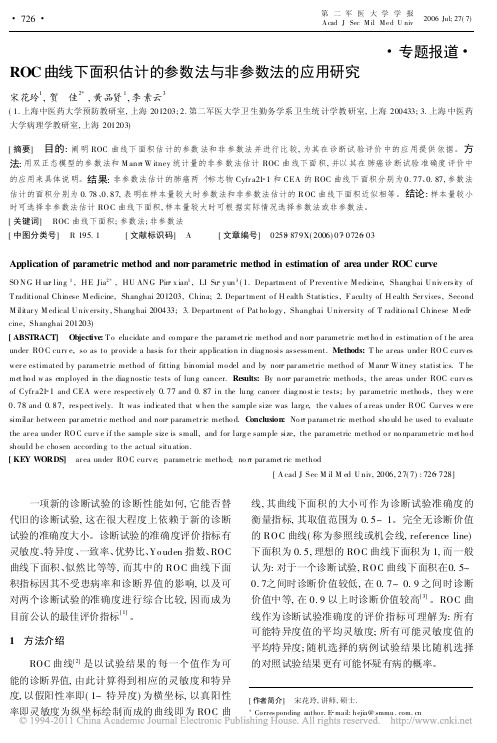
726第二军医大学学报Acad J Sec M il M ed U niv2006Jul;27(7)专题报道ROC 曲线下面积估计的参数法与非参数法的应用研究宋花玲1,贺 佳2*,黄品贤1,李素云3(1.上海中医药大学预防教研室,上海201203;2.第二军医大学卫生勤务学系卫生统计学教研室,上海200433;3.上海中医药大学病理学教研室,上海201203)[摘要]目的:阐明ROC 曲线下面积估计的参数法和非参数法并进行比较,为其在诊断试验评价中的应用提供依据。
方法:用双正态模型的参数法和M annW itney 统计量的非参数法估计ROC 曲线下面积,并以其在肺癌诊断试验准确度评价中的应用来具体说明。
结果:非参数法估计的肺癌两个标志物Cyfr a21 1和CEA 的ROC 曲线下面积分别为0.77、0.87,参数法估计的面积分别为0.78、0.87,表明在样本量较大时参数法和非参数法估计的R OC 曲线下面积近似相等。
结论:样本量较小时可选择非参数法估计RO C 曲线下面积,样本量较大时可根据实际情况选择参数法或非参数法。
[关键词] ROC 曲线下面积;参数法;非参数法[中图分类号] R 195.1 [文献标识码] A [文章编号] 0258 879X(2006)07 0726 03Application of parametric method and non parametric method in estimation of area under ROC curveSO N G H ua ling 1,HE Jia 2*,HU AN G Pin x ian 1,LI Su y un 3(1.Department of P reventiv e M edicine,Shang hai U niv ersity of T raditional Chinese M edicine,Shanghai 201203,China; 2.Depar tment o f H ealth Statistics,F aculty of H ealth Ser vices,Second M ilitar y M edical U niv ersity ,Shang hai 200433; 3.Department o f Pat ho lo gy ,Shanghai U niversity of T raditio na l Chinese M edi cine,Shanghai 201203)[ABSTRACT] Objective:T o elucidate and co mpar e the par amet ric method and non parametr ic met ho d in estimatio n o f t he area under RO C curv e,so as to pr ovide a basis fo r their applicatio n in diag no sis assessment.Methods:T he ar eas under RO C curv es wer e estimated by parametr ic method of fitting binomial mo del and by non par ametric method of M ann W itney statist ics.T he met ho d w as employed in the diag nostic tests of lung cancer.Results:By non par ametric methods,the areas under ROC curv es of Cyfr a21 1and CEA wer e respectiv ely 0.77and 0.87in the lung cancer diag no st ic tests;by par ametric metho ds,they w ere 0.78and 0.87,respect ively.It was indicated that w hen the sample size was larg e,the v alues o f a reas under R OC Cur ves w ere similar between par ametric method and non parametr ic metho d.C onclusion:No n paramet ric method sho uld be used to evaluate the ar ea under RO C curv e if the sample size is small,and for larg e sample size,the par ametric method o r no nparametr ic met ho d should be cho sen according to the actual situation.[KEY WORDS] ar ea under RO C curv e;parametr ic metho d;no n par amet ric method[A cad J Sec M il M ed U niv,2006,27(7):726 728][作者简介] 宋花玲,讲师,硕士.*Corres ponding author.E mail:h ejia@一项新的诊断试验的诊断性能如何,它能否替代旧的诊断试验,这在很大程度上依赖于新的诊断试验的准确度大小。
R语言ROC曲线截断值、特异性、敏感性和曲线下面积AUC值的计算和显示

R语言ROC曲线截断值、特异性、敏感性和曲线下面积AUC值的计算和显示**R语言绘制ROC曲线在临床医学中的应用**#计算体脂率对诊断妊娠期糖尿病的ROC曲线、截断值sumExcel1.2018合4_列合并症<- read.csv(“C:\Users\Desktop\sumExcel1_2019071.csv”,sep =“,”,header = TRUE)#读取数据,excel中数据格式如下图,数据有空值,符合实际应用情况attach(sumExcel1.2018合4_列合并症)print(sumExcel1.2018合4_列合并症)#options(scipen = 1000)#样本超过一千才使用科学计数法#var2 <- sumExcel1.2018合4_列合并症[c('体脂百分百_percent’,诊断妊娠期糖尿病0正常1 患病’)]var2 <- subset(sumExcel1.2018合4_列合并症,!is.na(sumExcel1.2018合4_列合并症['体脂百分百_percent’])&!is.na(sumExcel1.2018合4_列合并症['诊断妊娠期糖尿病0正常1患病’]),select=c('体脂百分百_percent’,诊断妊娠期糖尿病0正常1患病’))#install.packages(“pROC”)#此程辑包要求R版本更新至3.5.1以上,仅第一次使用需要安装library(pROC)#载入pROC包modelroc <- roc(var2 '诊断妊娠期糖尿病0正常1患病',var2 ′诊断妊娠期糖尿病0正常1患病′,var2’体脂百分百_percent’)#计算体脂率对诊断妊娠期糖尿病的ROC曲线plot(modelroc, print.auc=TRUE, auc.polygon=TRUE, grid=c(0.1, 0.2),grid.col=c(“green”, “red”), max.auc.polygon=TRUE,#设置坐标系网格纵、横坐标虚线分别为绿色、红色,曲线上颜色T灰色F无色,显示AUC曲线下面积auc.polygon.col=“skyblue”, print.thres=TRUE)#设置曲线下填充天蓝色detach(sumExcel1.2018合4_列合并症)体脂率判断妊娠期糖尿病的ROC曲线如下图,其曲线下面积AUC最大值0.61,对应截断值13.500kg,特异性0.402、敏感性0.793,说明体脂率高达13.5kg时判断妊娠期糖尿病发生的敏感性为79.3%,特异性为40.2%,(临床意义)使用该指标进行妊娠期糖尿病风险筛查具有较好的意义,但其确诊把握不足。
roc曲线最佳诊断标准

roc曲线最佳诊断标准全文共四篇示例,供读者参考第一篇示例:ROC曲线,全称为Receiver Operating Characteristic curve,是一种评估二分类模型性能的方法,常用于医学诊断、机器学习等领域。
在ROC曲线中,横轴表示假阳性率(false positive rate,FPR),纵轴表示真阳性率(true positive rate,TPR),通过绘制不同阈值下的FPR和TPR,可以得到一条曲线,该曲线下方的面积即为AUC (Area Under Curve),AUC值越大,说明模型性能越好。
ROC曲线最佳诊断标准即为在ROC曲线上的一个点或者一条线,该点或线对应的阈值是最优的,可以在保证高敏感性的同时保持较高的特异性,从而实现最佳的诊断效果。
在实际应用中,选择最佳标准可以帮助医生准确诊断疾病、预测患者的风险等。
那么如何确定ROC曲线最佳诊断标准呢?通常有以下几种方法:1. Youden指数法:Youden指数(Youden Index)是TPR和FPR 之差的绝对值,即Youden指数=TPR-FPR,当Youden指数最大时对应的阈值即为最佳标准。
Youden指数法适用于在不同领域、不同实验条件下的ROC曲线最佳标准选择。
2. 最近点法:最近点法是指在ROC曲线上找到离(0,1)点最近的点,该点对应的阈值即为最佳标准。
最近点法适用于ROC曲线上有多个交叉点时的最佳标准选择。
3. Youden指数和AUC相结合法:有些情况下,Youden指数最大对应的阈值可能不是最佳标准,因为Youden指数只考虑了最大化TPR和最小化FPR,而没有考虑到整个ROC曲线的形状。
可以结合AUC值来确定最佳标准,即在Youden指数较大的情况下,选择AUC 值较高的点为最佳标准。
4. 临床实际需求法:在确定ROC曲线最佳标准时,还应考虑到具体的临床实际需求。
比如在疾病诊断中,对于不同的病人群体,可能需要根据病情严重程度、治疗方案等因素来确定最佳标准。
roc曲线法参考值
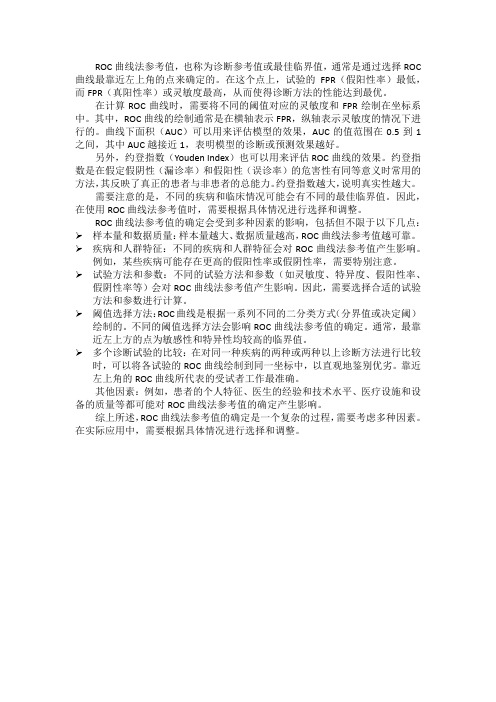
ROC曲线法参考值,也称为诊断参考值或最佳临界值,通常是通过选择ROC 曲线最靠近左上角的点来确定的。
在这个点上,试验的FPR(假阳性率)最低,而FPR(真阳性率)或灵敏度最高,从而使得诊断方法的性能达到最优。
在计算ROC曲线时,需要将不同的阈值对应的灵敏度和FPR绘制在坐标系中。
其中,ROC曲线的绘制通常是在横轴表示FPR,纵轴表示灵敏度的情况下进行的。
曲线下面积(AUC)可以用来评估模型的效果,AUC的值范围在0.5到1之间,其中AUC越接近1,表明模型的诊断或预测效果越好。
另外,约登指数(Youden Index)也可以用来评估ROC曲线的效果。
约登指数是在假定假阴性(漏诊率)和假阳性(误诊率)的危害性有同等意义时常用的方法,其反映了真正的患者与非患者的总能力。
约登指数越大,说明真实性越大。
需要注意的是,不同的疾病和临床情况可能会有不同的最佳临界值。
因此,在使用ROC曲线法参考值时,需要根据具体情况进行选择和调整。
ROC曲线法参考值的确定会受到多种因素的影响,包括但不限于以下几点:➢样本量和数据质量:样本量越大、数据质量越高,ROC曲线法参考值越可靠。
➢疾病和人群特征:不同的疾病和人群特征会对ROC曲线法参考值产生影响。
例如,某些疾病可能存在更高的假阳性率或假阴性率,需要特别注意。
➢试验方法和参数:不同的试验方法和参数(如灵敏度、特异度、假阳性率、假阴性率等)会对ROC曲线法参考值产生影响。
因此,需要选择合适的试验方法和参数进行计算。
➢阈值选择方法:ROC曲线是根据一系列不同的二分类方式(分界值或决定阈)绘制的。
不同的阈值选择方法会影响ROC曲线法参考值的确定。
通常,最靠近左上方的点为敏感性和特异性均较高的临界值。
➢多个诊断试验的比较:在对同一种疾病的两种或两种以上诊断方法进行比较时,可以将各试验的ROC曲线绘制到同一坐标中,以直观地鉴别优劣。
靠近左上角的ROC曲线所代表的受试者工作最准确。
受试者工作特征曲线 roc下的面积auc值的计算公式

我们要找出受试者工作特征曲线(ROC)下的面积(AUC)值的计算公式。
首先,我们需要了解ROC曲线和AUC的概念。
ROC曲线是显示真正类率(True Positive Rate, TPR)与假正类率(False Positive Rate, FPR)的曲线。
AUC是ROC曲线下的面积,它表示分类器的性能。
AUC值越接近1,表示分类器的性能越好。
AUC的计算公式是:
AUC = ∫ TPR(FPR) dFPR
其中,TPR(FPR)表示在给定的FPR下的TPR值。
这个公式告诉我们如何计算ROC曲线下的面积,也就是AUC值。
计算AUC值时,需要先找到TPR和FPR之间的关系,然后使用积分来计算AUC。
在实际应用中,我们通常使用计算机软件来计算AUC值,例如使用Python的scikit-learn 库。
总结:AUC的计算公式是∫ TPR(FPR) dFPR,它表示ROC曲线下的面积。
在实际应用中,我们通常使用计算机软件来计算AUC值。
roc曲线的面积

ROC曲线也被称为受试者工作特征(AUC)曲线,是用于评估模型性能的重要工具。
ROC曲线下的面积(AUC)可以用来衡量模型的性能,它是一个在0到1之间的数值,越接近1表示模型性能越好。
ROC曲线是根据不同阈值下的敏感性和特异性绘制出来的,面积(AUC)实际上是一个对数变换的结果,反映的是曲线下的面积。
另外,如果对于所有的结果都计算出了对应的ROC曲线下的面积,即单独对所有结果进行的AUC评估被称为总体的AUC。
通常在医学领域中,ROC曲线下的面积大于0.5通常被认为是比较理想的结果。
请注意,不同的模型可能会有不同的最佳阈值,这会影响敏感性和特异性,进而影响ROC曲线和AUC的值。
此外,不同领域的数据集可能对ROC曲线的解读会有不同的要求。
用Excel绘制ROC曲线(受试者工作特征曲线)计算临界值参考值、AUC-ROC曲线下面积
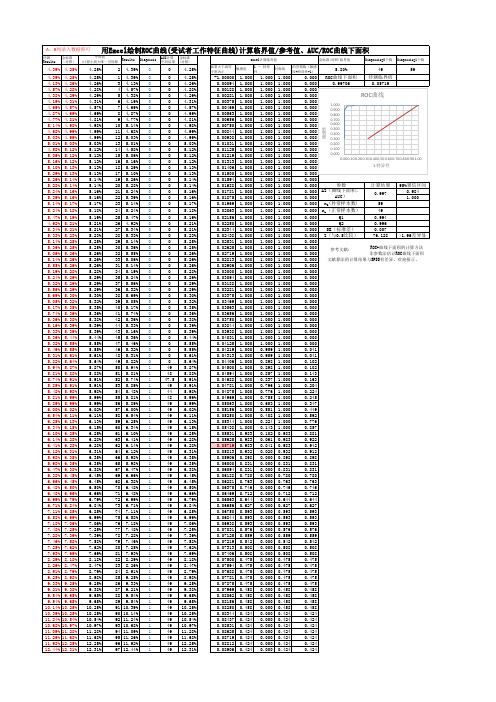
待测
金标准
Results (对照)
4.39% 4.25%
4.39% 4.13% 4.57% 4.38% 4.19% 4.69% 4.87% 4.77% 5.14% 4.68% 5.03% 5.01% 4.58% 5.06% 5.16% 5.10% 5.29% 5.26% 5.28% 5.24% 5.39%
金标准 (对照)
4.25%
4.25% 4.26% 4.28% 4.29% 4.31% 4.57% 4.69% 4.81% 4.98% 4.99% 4.99% 5.03% 5.12% 5.12% 5.12% 5.13% 5.13% 5.14% 5.14% 5.16% 5.16%
5.17%
5.18%
5.19% 5.21% 5.21% 5.23% 5.25% 5.25% 5.26% 5.26% 5.26% 5.28% 5.29% 5.29% 5.29% 5.30% 5.32% 5.35% 5.36% 5.38% 5.39% 5.39% 5.44% 5.55% 5.55% 5.61% 5.64% 5.87% 5.88% 5.91% 5.91% 5.98% 5.99% 5.99% 6.02% 6.11% 6.13% 6.15% 6.25% 6.28% 6.28% 6.31% 6.35% 6.35% 6.38% 6.45% 6.45% 6.50% 6.66% 6.79% 6.84% 6.85% 6.99% 7.06% 7.25% 7.39% 7.58% 7.62% 7.69% 8.18% 8.47% 8.79% 8.98% 9.25% 9.38% 9.65% 9.65% 10.25% 10.25% 10.54% 10.97% 11.28% 11.68% 12.25% 12.31%
roc曲线名词解释
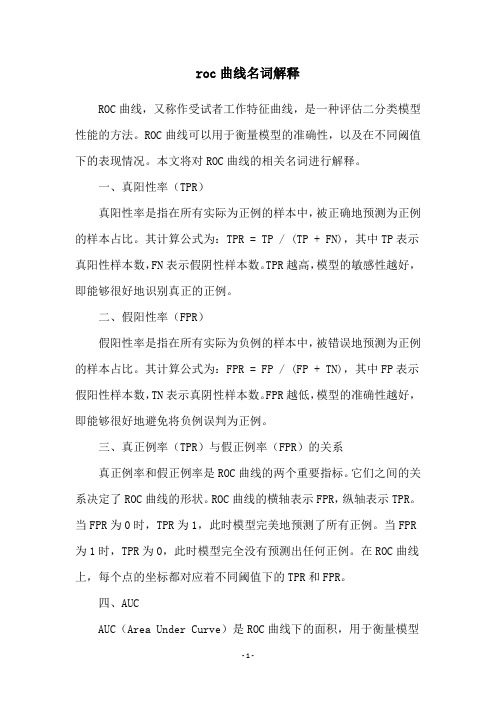
roc曲线名词解释ROC曲线,又称作受试者工作特征曲线,是一种评估二分类模型性能的方法。
ROC曲线可以用于衡量模型的准确性,以及在不同阈值下的表现情况。
本文将对ROC曲线的相关名词进行解释。
一、真阳性率(TPR)真阳性率是指在所有实际为正例的样本中,被正确地预测为正例的样本占比。
其计算公式为:TPR = TP / (TP + FN),其中TP表示真阳性样本数,FN表示假阴性样本数。
TPR越高,模型的敏感性越好,即能够很好地识别真正的正例。
二、假阳性率(FPR)假阳性率是指在所有实际为负例的样本中,被错误地预测为正例的样本占比。
其计算公式为:FPR = FP / (FP + TN),其中FP表示假阳性样本数,TN表示真阴性样本数。
FPR越低,模型的准确性越好,即能够很好地避免将负例误判为正例。
三、真正例率(TPR)与假正例率(FPR)的关系真正例率和假正例率是ROC曲线的两个重要指标。
它们之间的关系决定了ROC曲线的形状。
ROC曲线的横轴表示FPR,纵轴表示TPR。
当FPR为0时,TPR为1,此时模型完美地预测了所有正例。
当FPR 为1时,TPR为0,此时模型完全没有预测出任何正例。
在ROC曲线上,每个点的坐标都对应着不同阈值下的TPR和FPR。
四、AUCAUC(Area Under Curve)是ROC曲线下的面积,用于衡量模型的整体性能。
AUC的取值范围在0到1之间,值越靠近1,表示模型的性能越好。
当AUC为0.5时,表示模型的预测效果与随机猜测相当。
AUC的计算方法是将ROC曲线下的面积进行累加,即AUC = ∑(TPRi+TPRi-1)(FPRi-FPRi-1)/2,其中i表示不同阈值下的TPR和FPR。
五、阈值阈值是指将概率转化为二分类的判断点。
在机器学习中,模型会根据数据的特征和标签进行学习,最终输出一个概率值。
如果将概率值与阈值进行比较,大于阈值则判断为正例,小于阈值则判断为负例。
不同的阈值会影响模型的预测结果,因此需要根据实际需求进行设置。
ROC介绍及AUC计算方法

ROC介绍及AUC计算方法ROC(接受者操作特性曲线)是一种用于评估分类模型性能的常用方法,特别适用于二分类问题。
它是根据可视化曲线来衡量分类器的准确性,提供了在不同阈值下的分类器敏感性和特异性之间的权衡关系。
ROC曲线是由真阳性率(True Positive Rate,TPR)和假阳性率(False Positive Rate,FPR)绘制而成的。
TPR是在实际正例中正确预测为正例的比例,即TPR=TP/(TP+FN),其中TP表示真阳性,FN表示假阴性。
而FPR则是在实际负例中错误预测为正例的比例,即FPR=FP/(FP+TN),其中FP表示假阳性,TN表示真阴性。
ROC曲线的横轴代表FPR,纵轴代表TPR。
在二分类问题中,横纵坐标的值都在0到1之间。
当分类器的阈值设置为0时,所有样本都会被预测为正例,此时TPR和FPR都为1、而当阈值设置为1时,所有样本都会被预测为负例,此时TPR和FPR都为0。
ROC曲线是根据分类器在不同阈值下的TPR和FPR计算得到的。
ROC曲线的面积被称为AUC(Area Under the Curve),AUC是一个单一的度量,表示ROC曲线下的面积大小。
AUC的取值范围在0到1之间,越接近1则表示分类器性能越好。
当AUC接近于0.5时,表示分类器的预测性能没有优势,等同于随机猜测。
而当AUC接近于1时,表示分类器具有很高的区分能力,能够很好地对正例和负例进行分类。
计算AUC的方法有多种,以下是一种常用的计算方法:1.将数据集根据预测概率从大到小进行排序。
2.初始化TPR和FPR的值均为0。
3.从排序后的数据集中逐个样本计算TPR和FPR的值。
如果当前样本为正例,则将TPR的值增加一个单位;如果为负例,则将FPR的值增加一个单位。
4.以TPR为纵轴,FPR为横轴,在坐标系上绘制对应的点,得到ROC 曲线。
5.计算ROC曲线下的面积,即AUC。
AUC的计算方法可以通过数学求积分得到,也可以通过计数法计算。
联合因素的roc曲线
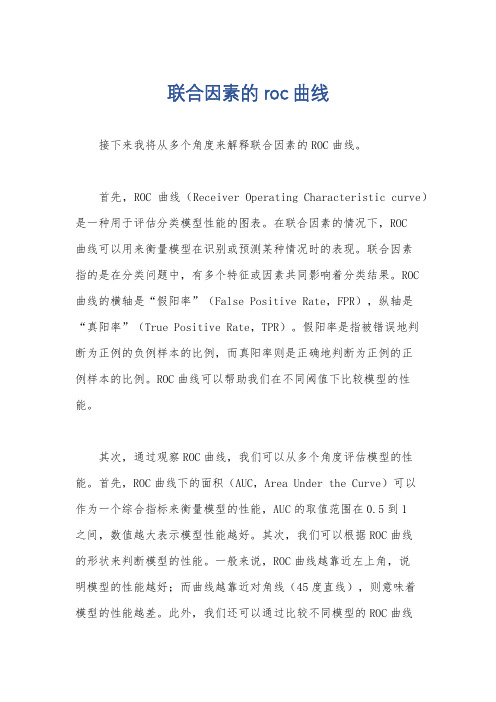
联合因素的roc曲线接下来我将从多个角度来解释联合因素的ROC曲线。
首先,ROC曲线(Receiver Operating Characteristic curve)是一种用于评估分类模型性能的图表。
在联合因素的情况下,ROC曲线可以用来衡量模型在识别或预测某种情况时的表现。
联合因素指的是在分类问题中,有多个特征或因素共同影响着分类结果。
ROC曲线的横轴是“假阳率”(False Positive Rate,FPR),纵轴是“真阳率”(True Positive Rate,TPR)。
假阳率是指被错误地判断为正例的负例样本的比例,而真阳率则是正确地判断为正例的正例样本的比例。
ROC曲线可以帮助我们在不同阈值下比较模型的性能。
其次,通过观察ROC曲线,我们可以从多个角度评估模型的性能。
首先,ROC曲线下的面积(AUC,Area Under the Curve)可以作为一个综合指标来衡量模型的性能,AUC的取值范围在0.5到1之间,数值越大表示模型性能越好。
其次,我们可以根据ROC曲线的形状来判断模型的性能。
一般来说,ROC曲线越靠近左上角,说明模型的性能越好;而曲线越靠近对角线(45度直线),则意味着模型的性能越差。
此外,我们还可以通过比较不同模型的ROC曲线来选择最优模型。
最后,需要注意的是,ROC曲线并不适用于所有类型的分类问题,特别是在样本不平衡的情况下。
在处理联合因素的分类问题时,我们需要综合考虑模型的ROC曲线、AUC值以及具体业务场景下的需求,来全面评估模型的性能。
综上所述,联合因素的ROC曲线是衡量模型性能的重要工具,通过综合考虑曲线形状、AUC值以及业务需求,我们可以全面评估模型在联合因素分类问题中的表现。
希望以上解释能够对你有所帮助。
roc.area函数

roc.area函数
`roc.area`函数通常是指用于计算接收者操作特征曲线(ROC
曲线)下的面积。
ROC曲线是一种用于评估二元分类器性能的图形
工具,横轴表示假阳率(False Positive Rate),纵轴表示真阳率(True Positive Rate)。
在Python中,常用的计算ROC曲线下面
积的方法是使用scikit-learn库中的`roc_auc_score`函数。
这个
函数可以计算ROC曲线下的面积,即AUC(Area Under the Curve)值,用于衡量分类器的性能。
在使用`roc_auc_score`函数时,需要将分类器的预测概率和真
实标签作为输入。
该函数会对预测概率进行排序,并根据不同的阈
值计算真阳率和假阳率,然后计算ROC曲线下的面积。
这个面积的
取值范围在0.5到1之间,值越大表示分类器性能越好。
除了使用现成的函数外,也可以手动计算ROC曲线下的面积。
这通常涉及到对ROC曲线进行数值积分,可以使用梯形法则或其他
数值积分方法来近似计算ROC曲线下的面积。
总之,`roc.area`函数通常用于计算ROC曲线下的面积,用于
评估分类器的性能。
在Python中,可以使用scikit-learn库中的`roc_auc_score`函数来实现这一功能。
roc_auc指标 -回复

roc_auc指标-回复什么是ROC-AUC指标?在机器学习领域,评估模型性能是非常重要的一个步骤。
为了衡量分类模型的性能,我们可以使用许多指标,其中之一是ROC曲线下的面积(ROC-AUC)。
本文将介绍ROC-AUC指标的概念、计算方法以及其在实践中的应用。
首先要理解什么是ROC曲线。
ROC(Receiver Operating Characteristic)曲线是一种用于评估分类模型的性能的图形工具。
ROC曲线的横轴表示模型的假阳性率(False Positive Rate, FPR),纵轴表示模型的真阳性率(True Positive Rate, TPR)。
模型的真阳性率也称为灵敏度(Sensitivity),而模型的假阳性率则反映了分类器的误指率。
根据设定的分类阈值,模型的输出将被归类为正类或负类。
但阈值的设定会对模型的预测结果产生影响。
所以,在绘制ROC曲线时,我们将分类模型在不同阈值下的表现进行比较。
ROC曲线能够展示分类器在不同灵敏度和误指率之间的权衡。
ROC-AUC指标(area under the ROC curve)是ROC曲线下的面积,即ROC曲线与坐标轴之间的面积。
ROC-AUC的取值范围在0到1之间,其中0.5代表随机分类器,1代表完美分类器。
ROC-AUC越接近于1,说明分类模型的性能越好。
那么,如何计算ROC-AUC指标呢?通常,可以通过数值积分或近似算法来计算ROC曲线下的面积。
另一种计算方法是使用Mann-Whitney U检验,计算该检验对应的p-value,来评估ROC-AUC的显著性。
在实际应用中,ROC-AUC指标有很多的应用场景。
例如,在医学诊断中,ROC-AUC可用于评估分类模型在区分患者和健康群体时的性能。
此外,在金融领域,ROC-AUC可以用于评估信用评分模型的有效性,帮助银行筛选出好的借款人。
另外,ROC-AUC还广泛应用于广告点击率预测、恶意软件检测、客户流失预测等领域。
影像学auc

影像学auc影像学AUC是衡量医学影像学筛查技术效果的重要指标之一,意为受试者工作特征曲线下的面积,是评价一种筛查方法的准确性和灵敏性的重要指标。
那么,什么是影像学AUC?如何计算影像学AUC呢?下面我们就来一步步解读。
一、什么是影像学AUC?影像学AUC(Area Under the Curve)是衡量一种筛查方法准确性和灵敏性的重要指标,也称ROC曲线下的面积。
在医学影像学领域,研究人员通过绘制受试者操作特征(ROC)曲线,计算其下的面积来评估一种筛查方法的效果。
AUC的取值范围通常在0.5到1之间,1表示完全准确,0.5表示随机猜测,越接近1说明该方法的效果越好。
二、如何计算影像学AUC?影像学AUC的计算需要构建ROC曲线,步骤如下:1、收集样本数据,包括阳性和阴性样本,其中阳性样本指有疾病的患者,阴性样本指无疾病的健康人群;2、利用医学影像学技术对样本进行筛查和诊断,得出阳性和阴性诊断结果;3、根据样本的真实情况和诊断结果,计算各自的灵敏度和特异度,其中灵敏度指对阳性样本诊断正确的比例,特异度指对阴性样本诊断正确的比例;4、制作ROC曲线,横坐标表示1-特异度,纵坐标表示灵敏度,绘制各个阈值下的ROC曲线;5、计算ROC曲线下的面积AUC,根据计算公式:AUC=(灵敏度之和/阳性样本数量)*(1-特异度之和/阴性样本数量)。
值得注意的是,在构建ROC曲线时,通常会选择不同的阈值来分析筛查技术的应用效果,此时不同的阈值对应不同的灵敏度和特异度,因此绘制的ROC曲线也会不同。
一般来说,ROC曲线越接近左上角,表明筛查技术的灵敏度和特异度越高,AUC值也越大,说明该筛查技术的效果越好。
综上所述,影像学AUC是一个重要的医学影像学筛查技术效果指标,其计算需要根据真实样本数据构建ROC曲线,计算曲线下的面积。
通过AUC的值大小,我们可以初步判断一种筛查技术的应用效果。
当然,还需要结合具体的临床应用情境来进行深入分析和评估。
mpa的auc公式

mpa的auc公式
MPA的AUC(Area Under the Curve)是一种常用的评估指标,用于衡量分类模型的性能。
AUC的取值范围在0到1之间,数值越接近1,表示模型的性能越好。
AUC是ROC曲线下的面积,ROC曲线是以真阳性率(True Positive Rate,TPR)为纵轴,假阳性率(False Positive Rate,FPR)为横轴绘制的曲线。
TPR是指在所有阳性样本中,被正确预测为阳性的比例;FPR是指在所有阴性样本中,被错误预测为阳性的比例。
通过计算ROC曲线下的面积,可以得到模型的AUC值。
AUC值越大,说明模型的真阳性率相对于假阳性率更高,即模型更准确地区分了阳性和阴性样本。
为了计算AUC值,首先需要根据模型的预测结果对样本进行排序,将阳性样本排在前面,阴性样本排在后面。
然后,根据不同的阈值,可以计算出不同的TPR和FPR。
通过绘制TPR-FPR曲线,即ROC 曲线,可以得到AUC值。
在实际应用中,AUC可以用于比较不同分类模型的性能。
较高的AUC值意味着模型具有更好的分类能力,可以更准确地判断样本的分类。
总结起来,MPA的AUC是一种用于评估分类模型性能的指标,通过计算ROC曲线下的面积来衡量模型的分类准确性。
AUC值越大,表
示模型的性能越好。
通过比较不同模型的AUC值,可以选择性能更好的模型。
- 1、下载文档前请自行甄别文档内容的完整性,平台不提供额外的编辑、内容补充、找答案等附加服务。
- 2、"仅部分预览"的文档,不可在线预览部分如存在完整性等问题,可反馈申请退款(可完整预览的文档不适用该条件!)。
- 3、如文档侵犯您的权益,请联系客服反馈,我们会尽快为您处理(人工客服工作时间:9:00-18:30)。
data _null_;
infile _ver;
input name:$15. ver;
if upcase(name)="&sysmacroname" then call symput("_newver",ver);
nx[i,j] = m; ny[i,j] = n;
mi = (psii#inow)[+] / m; * means;
mj = (psij#inow)[+] / m;
t[i,j] = mi; t[j,i] = mj;
free rz loc nx ny; * free space ;
finish;
start mwvar(t,v,nx,ny,z);
*;
* compute mann-whitney statistics and variance;
%goto exit;
%end;
/* Verify that VAR= option is specified */
%if &var= %then %do;
%put ERROR: Specify predictor or XBETA variables in the VAR= argument;
data _comp(keep = &var &response);
%if &daห้องสมุดไป่ตู้a=%str() or &ndata=1 %then set;
%else merge;
&data;
if &response not in (0,1) then call symput('error',1);
*
* psi is the returned vector of u-statistic components;
rz = ranktie( z[,1] ); * average ranks;
nx = sum( z[,2] ); * num. of Xs ;
psii = psii-mi; psij = psij-mj; * center;
v[i,j] = (psii#psij#inow)[+] / (m#(m-1))
+ (psii#psij#(1-inow))[+] / (n#(n-1));
* single column of values.
* v is the k by k estimated variance matrix;
* nx is the matrix of x population counts on a pairwise basis;
* ny is the matrix of y population counts on a pairwise basis;
read all into data [colname=names];
ny = nrow(z)-nx; * num of Ys ;
loc = loc( z[,2]=1 ); * x indexes ;
psi = j(nrow(z),1,0);
v[j,i] = v[i,j];
end;
end;
free psii psij inow ind who;
finish;
/* start of execution of the IML program */
use _comp var {&var &response};
%end;
title "The ROC Macro";
title2 " ";
%let error=0;
/* Verify that DATA= option is specified */
%if &data= %then %do;
%put ERROR: Specify DATA= containing the OUT= data sets of models to be compared;
run;
%if &syserr ne 0 %then
%put ROC: Unable to check for newer version;
%else %if %sysevalf(&_newver > &_version) %then %do;
%put ROC: A newer version of the ROC macro is available.;
do j=1 to i;
who = loc( (z[,i]^=.)#(z[,j]^=.) ); * nonmissing pairs;
run mwcomp(psii,(z[,i]||ind)[who,]); * components;
run mwcomp(psij,(z[,j]||ind)[who,]);
%goto exit;
%end;
%let i=1;
%do %while (%scan(&data,&i) ne %str() );
%let data&i=%scan(&data,&i);
%let i=%eval(&i+1);
%end;
%let ndata=%eval(&i-1);
* z[,2] is the column of indicator variables;
* z[i,2]=1 if the observation is from the x population;
* z[i,2]=0 if the observation is from the y population;
%macro roc(version, data=, var=, response=, contrast=, details=no,
alpha=.05);
%let _version=1.7;
%if &version ne %then %put ROC macro Version &_version;
* values or it is desired to use the components without doing
* pairwise deletion first, the nested do loops could be evaded.
*;
do i=1 to k;
k = ncol(z)-1;
ind = z[,k+1];
v = j(k,k,0); t=v; nx=v; ny=v;
* The following computes components after pairwise deletion of
* observations with missing values. If either there are no missing
%goto exit;
%end;
/* Verify that RESPONSE= option is specified */
%if &response= %then %do;
%put ERROR: Specify response variable in the RESPONSE= argument;
* i-th column when used with the j-th column. The only
* observations with nonmissing values in each column are
* used. The diagonal elements are, hence, based only on the
proc iml;
start mwcomp(psi,z);
*;
* program to compute the mann-whitney components ;
* z is (nn by 2);
* z[,1] is the column of data values;
* 0 if the observation is from population y;
* t is the k by k vector of estimated statistics;
* the (i,j) entry is the MannWhitney statistic for the
inow = ind[who,]; * Xs and Ys;
m = inow[+]; * current Xs;
n = nrow(psii)-m; * current Ys;
* input z, n by (k+1);
* z[,1:k] are the different variables;
* z[,k+1] are indicator values,
* 1 if the observation is from population x and ;
%let opts = %sysfunc(getoption(notes))
_last_=%sysfunc(getoption(_last_));
options nonotes;
/* Check for newer version */
